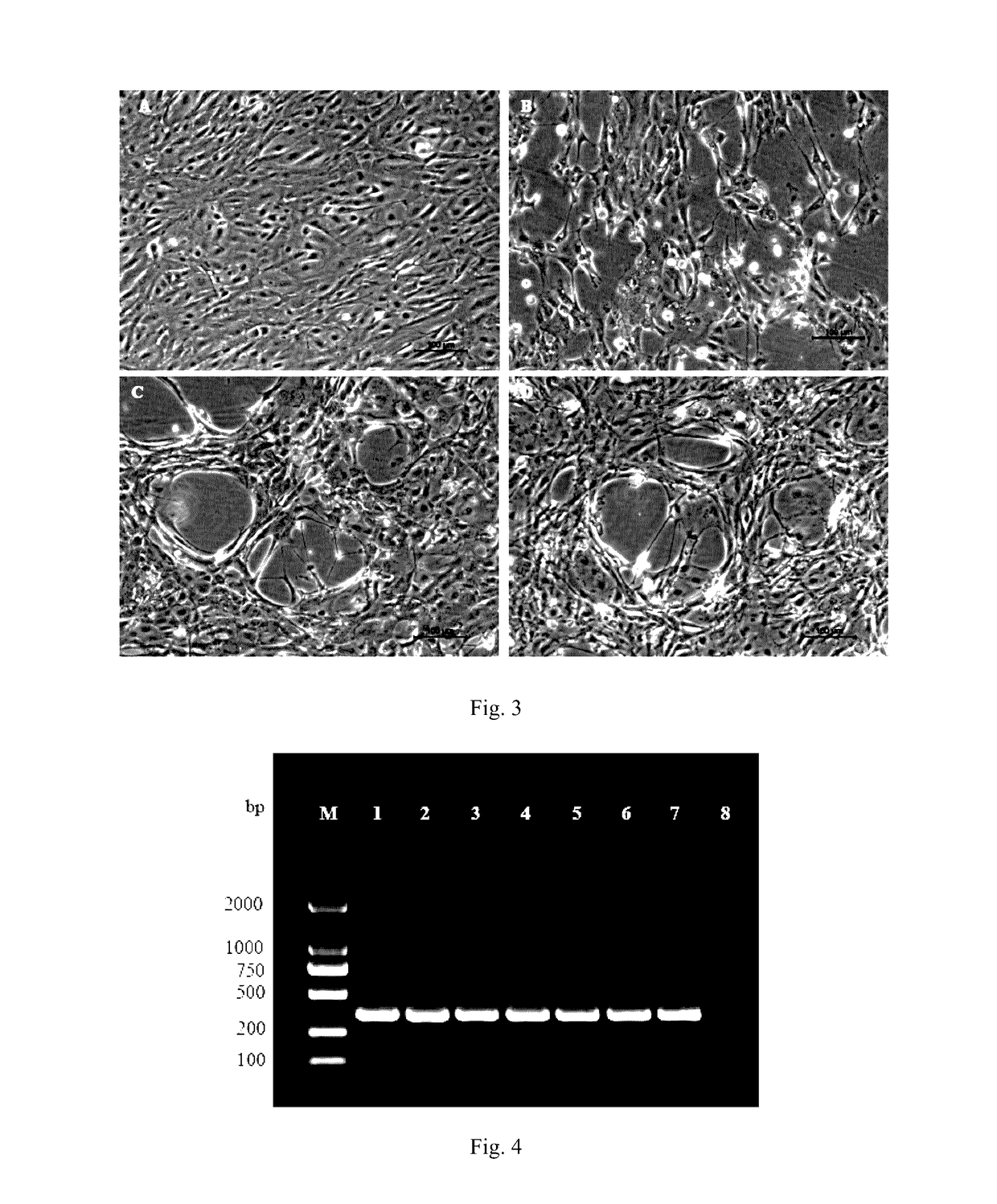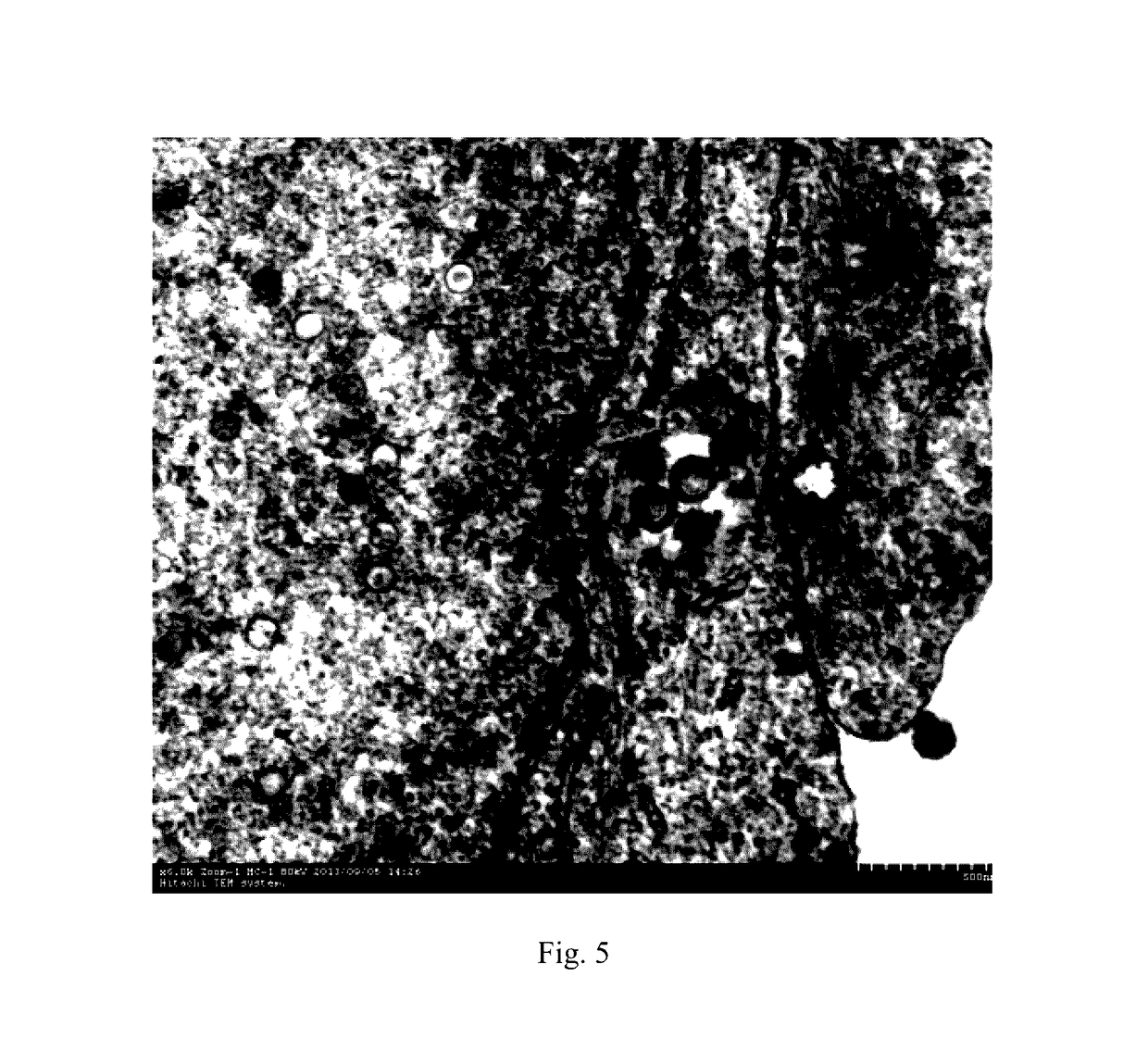Cyprinid herpesvirus II-sensitive brain tissue cell line of Carassius auratus gibelio and establishing method and use thereof
a brain tissue and cyprinid herpes virus technology, applied in the field of hydrobiologic cells, can solve the problems of difficult to proliferate cyprinid herpesvirus-2 in common cell lines, threaten the development of crucian carp and goldfish aquaculture, and large economic losses, and achieves good biological activity, prevents and controls hematopoietic necrosis, and stable and obvious cytopathic
- Summary
- Abstract
- Description
- Claims
- Application Information
AI Technical Summary
Benefits of technology
Problems solved by technology
Method used
Image
Examples
example 1
[0037]Establishment of brain tissue cell line of Carassius auratus gibelio. The steps were as follows:
[0038](1) Treatment of brain tissue: The brain tissue of Carassius auratus gibelio was removed under sterile conditions and placed in a culture dish, rinsed with PBS for 3 times, and cut into tissues blocks of 50-100 mm3 with sterile ophthalmic scissors;
[0039](2) Primary culture: the cut tissue blocks were placed in and digested with 0.5 W / V % trypsin solution at 28° C. for 15 min. Meantime, it was shaked for 3 times. After digestion, an equal volume of culture solution special for brain tissue cells of Carassius auratus gibelio (hereinafter called “culture solution” for short, the culture solution being M199 culture medium containing 20% V / V fetal bovine serum, 10 ng / ml human basic fibroblast growth factor, 10 ng / ml human epidermal growth factor, 100 U / ml penicillin, 100 μg / ml streptomycin, 0.25 μg / ml amphotericin B) was added and pipetted uniformly, followed by filtered once with ...
example 2
[0042]Biological characteristics of the brain tissue cell line of Carassius auratus gibelio, GiCB:
[0043](1) Morphology: The cells are fibroblast-like cells.
[0044](2) Growth properties: The passage GiCB cells began to adhere to the wall 30 min after subculture and completely adhered to the wall 8 h after subculture. The population doubling time was 50.5 h.
[0045](3) Stability: The brain tissue cell line of Carassius auratus gibelio, GiCB, so far has been subcultured up to passage 65 and still grows in a stable proliferating status.
[0046](4) Frozen storage and recovery:
[0047]After recovery, the GiGB cells adhered to the wall rapidly. The growth morphology, status was similar to the cells without frozen storage, and there was no significant difference. The recovered cells was stained with trypan blue and counted by cell statistics. About (80.38±5.10) % of the cells were not stained and had cell activities.
[0048](5) Chromosome analysis
[0049]The 6th passage brain tissue cell line of Caras...
example 3
[0050]The applications of the cyprinid herpesvirus II-sensitive cell line of Carassius auratus gibelio. The process was as follows:
[0051](1) Collection and treatment of diseased sample infected with cyprinid herpesvirus II
[0052]kidney and spleen were collected from the diseased fish infected with cyprinid herpesvirus II that had just died, cut into pieces and homogenized with equal volume of PBS, centrifuged at 6000 rpm at 4° C. for 30 min, filtered through 0.22 μm membrane filter to obtain sterile tissue homogenate, packed and stored at −80° C. for use.
[0053](2) Proliferation of cyprinid herpesvirus II in GiCB
[0054]After GiCB was cultured to 80% monolayer cells, the medium was removed and the cells were washed twice with PBS. 1 ml of the above treated diseased tissue homogenate supernatant was inoculated into the cell monolayer. Polybrene was added with a final concentration of 10 μg / μl and incubated at 25° C. for 2 h, during which the flask was slightly shaken every 15-20 min so a...
PUM
| Property | Measurement | Unit |
|---|---|---|
| temperature | aaaaa | aaaaa |
| area | aaaaa | aaaaa |
| temperature | aaaaa | aaaaa |
Abstract
Description
Claims
Application Information
 Login to View More
Login to View More - R&D
- Intellectual Property
- Life Sciences
- Materials
- Tech Scout
- Unparalleled Data Quality
- Higher Quality Content
- 60% Fewer Hallucinations
Browse by: Latest US Patents, China's latest patents, Technical Efficacy Thesaurus, Application Domain, Technology Topic, Popular Technical Reports.
© 2025 PatSnap. All rights reserved.Legal|Privacy policy|Modern Slavery Act Transparency Statement|Sitemap|About US| Contact US: help@patsnap.com



